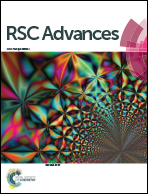A silver coordination cage assembled from [Ag2(bis(isoxazolyl))3]: DFT approach to the binding forces within the host–guest interactions†
Abstract
The storage and detection of different types of molecules using porous materials such as metal–organic frameworks (MOFs) has currently become an area of interest in chemistry. In this sense, non-covalent interactions in host–guest arrays are among the most significant topics to address. In this work, the inclusion of a series of gases in the cavity of a minimal secondary building unit (SBU), namely, [Ag2(bisox)3] as the host was studied in terms of their non-covalent interactions and optical properties using different computational approximations. The relevant interaction energies indicated favorable inclusion of incoming guests in the respective host. Consequently, the decomposition of the interaction energy within the Ziegler–Rauk scheme revealed significant differences within the series of studied gases. Hence, the potential selectivity of the [Ag2(bisox)3] cage for a particular gas within the series was investigated. Natural orbital for chemical valence (NOCV) analysis was carried out to visualize possible channels of charge transfer between the host–guest pairs. Non-covalent interaction (NCI) analysis supports the fact that different types of weak interaction are involved in the series of studied gases and highlights remarkable differences between polar and non-polar guests. Otherwise, the ability of the studied cage to trap gases was evidenced by changes in the spectral properties of the free cage with respect to those of cages containing guests. This was investigated via computational analysis of the UV-vis absorption spectra. Furthermore, electron density difference maps (EDDMs) were employed to reveal the character of the electron transitions.
![Graphical abstract: A silver coordination cage assembled from [Ag2(bis(isoxazolyl))3]: DFT approach to the binding forces within the host–guest interactions](/en/Image/Get?imageInfo.ImageType=GA&imageInfo.ImageIdentifier.ManuscriptID=C6RA22905K&imageInfo.ImageIdentifier.Year=2016)

 Please wait while we load your content...
Please wait while we load your content...